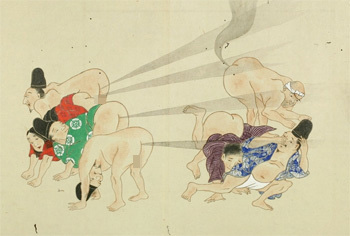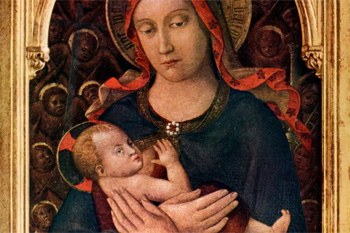4 Secretly Brilliant Details Of Art (You Mistook For Errors)

Art can be many things -- joyful, transcendental, incisive, political, personal, or Sonic The Hedgehog erotica. Those are all of them. Those are all of the things art can be. Well, we suppose it can also be weird and stupid. After all, history is fraught with inexplicable artistic trends which seem silly to modern-day people. But if you look into it, sometimes there's a very good explanation for ...
Dismembered Roman Sculptures (Were Really Roman Legos)

Why are so many Ancient Roman sculptures headless? Was it a tragic byproduct of time -- the neck is kind of a weak point, so the head usually falls off? Or was it a copout -- were all Roman artists pulling a Rob Liefield, stopping at the neck because heads are hard to sculpt? That can't be the case. We have plenty of surviving Roman busts with great detail. Bodies without heads, heads without bodies -- was it simply a super fucked-up time for art?

"You don't want to know what they stuck in my hand hole."
None of the above! Though we suspect at least a few sculptors breathed a sigh of relief when they first found out they didn't have to carve hair.
The dismembered statues are the result of a surprisingly practical move by the Romans. They were meant to be taken apart and put back together again in different configurations, like ghostly Cronenbergian Legos. The bodies were purposely generic, so detachable heads could be paired with the torso of your liking. Say, for example, you needed to whip up a cool new goddess on the spot.

Also great for sticking your head on, theme-park-cutout style.
This was most handy in the political realm. Whenever a new ruler came to the throne, the Senate could decree a damnatio memoriae. This meant that the old emperor's memory had to be erased from history. They'd remove his likeness from everything they saw, the same way you delete old Facebook photos of your ex. The old heads would be thrown away or recycled. Then, when the new emperor began his reign, a fresh batch o' noggins was sculpted and mounted to the franken-leader statues. And if the new emperor ever got too cocky, the Senate could clear their throats and point to the throat seam. He'd get the message.
The Kooky Japanese Fart Warriors (Were Blatant Political Dissent)

The classic art of ancient Japan. Those beautiful lines, that simple iconography. It's no wonder that girls who ride scooters tattoo it on their thighs. Why, let's take a look at one of those classy, timeless pieces ...

Alright, so has Japan just always been weird? Was anime culture an inevitability, rather than an unfortunate side effect?

(This is how every anime character levitates.)
Possibly! But despite the prevalence of these noble fart warriors on the internet -- you've seen them star in poorly assembled memes and as the "funny" guy's Twitter avatar -- this wasn't a trend, per se. All of the many fartblasting images, done up in their different fartistic styles by a litany of fartists, trace back to one piece: a massive, 34-foot scroll featuring some of the most vile acts the world could imagine before 2 Girls 1 Cup:

Now you know where Rule 34 got its name.
This scroll was an anthology work, with esteemed artists all across Japan coming together to contribute their individual pieces to one greater whole. You owe it to yourself to visit this site and browse the scroll in its windswept entirety, in glorious high definition.

This is why Japan invented ultra-wide monitors.
No, Japanese artists didn't weren't writing Dumb & Dumber fanfiction centuries before the movie. The whole ode to bodily functions was meant as political satire. In the Edo period, European influence in Japan was increasing. After 700 years, the rule of the shoguns had ended, and foreign bastards were rolling in with a vengeance. The Japanese hadn't asked for a Western trade invasion, and they weren't super stoked at the sudden influx of honkies. To spite the Westerners in the least subtle, most easily understood fashion, they gathered famous artists together to work on an epic mural devoted to Europeans and their collaborators (mostly wealthy merchants) being blasted away by Japanese farts. The foreigners saw this clear and unmistakable message of dissent and went, "Haha, Japan, you so crazy!"
And we've stood by that interpretation ever since.

Also explained: humanity's cat obsession.
Hilarious Ancient Greek Masks (Were Important Tools)

They look like the sort of goofy Halloween masks you find at the dollar store at 4:30 p.m. on October 31st, long after everything "good" (always a relative term at the dollar store) has been picked clean. But theater was big in Ancient Greece, and we mean that literally; humongous outdoor stadiums were needed to accommodate the crowds ...

Thousands broke their arms trying to wear giant stone "We're #1" hands.
They could seat up to 20,000 people, and since this all took place in that tragic era of human history before the invention of the big screen, the distance between actors and audience could get ridiculous. The ridiculously exaggerated masks were devised to help convey the performances to the squinting audience.

They still couldn't hear the play, but it didn't matter. It was all Greek to them.
They did have changing rooms for use between acts, but that still meant the actors were stuck with one overwrought emotion for an entire scene, whether it was appropriate or not. Think Telemundo soap opera, only everybody looked like this:

Or this:

Statler OR Waldorf.
The masks we see today aren't the ones they wore back in the day, but ornamental reproductions made of terracotta, bronze, and stone. Because no one likes a broken neck, the ones used by the actors were made of wood, and often featured a mass of "hair" sticking straight up from the forehead to draw even more attention. So again, just like Telemundo.
Medieval Babies Looking Like Tiny, Creepy Old Men (Were Inspired By Jesus, Who Was A ... Tiny, Creepy Old Man?)

All medieval paintings of babies look like somebody shrank an accountant:

"Christ, Antichrist, same diff."
But why? Were there no available babies to use as models? Were medieval babies just seriously disturbing?

Was prenatal ab care a big deal back then?
Actually, the man-babies were an intentional decision. At the time, society was set on the idea of the "homuncular Jesus" -- Christ being born a man, and only growing in size as he got older. That way, Jesus was always perfect, unchanging, and dignified. We get it. It's difficult to accept the idea that your savior was once a mewling baby, crapping himself and throwing SpaghettiOs at mom. But the unintentional end result of saying "He was always a cool dude" was the Divine Infant looking like he's about to buy a convertible in every portrait.

And Mom never seems that into him.
Since an overwhelming number of paintings at the time were commissioned by the Church, the strange depiction of man-baby Jesus became the "right" way to paint babies in general. Hence all medieval babies looking like they needed a few hours away from Carol and the kids.
The trend passed with time, presumably when somebody pointed out that baby-abs were way more unsettling than Jesus potentially spitting up on the Virgin Mary. Soon, he was once again depicted as a pinchable li'l cherub, art learned a valuable lesson, and it never did anything weird again.
Rachel P. dares you to follow her on Twitter @plehcar.
For more art lessons that'll make you the most interesting person ever, check out Great Art With Bizarre Flaws You Never Noticed & Can't Unsee and 7 Artists Whose Work Will Give You Nightmares.
Subscribe to our YouTube channel, and check out The 7 Most Baffling Pieces Of Art (Made With Genitals), and other videos you won't see on the site!
Follow us on Facebook, and we'll follow you everywhere.
Last Halloween, the Cracked Podcast creeped you out with tales of ghost ships, mysteriously dead people, and a man from one of the most famous paintings in U.S. history who years later went all Jack Nicholson in The Shining on his family. This October, Jack and the Cracked staff are back with special guest comedians Ryan Singer, Eric Lampaert, and Anna Seregina to share more unsettling and unexplained true tales of death, disappearance, and the great beyond. Get your tickets for this LIVE podcast here!
